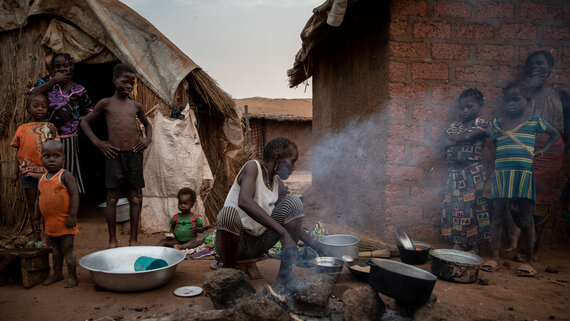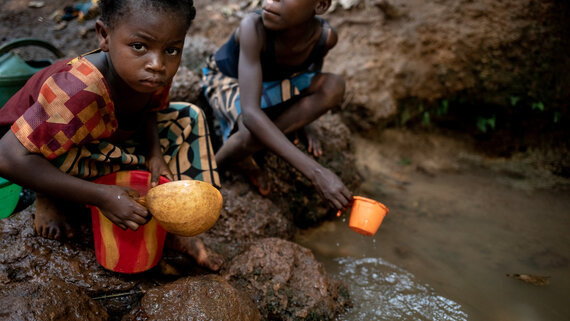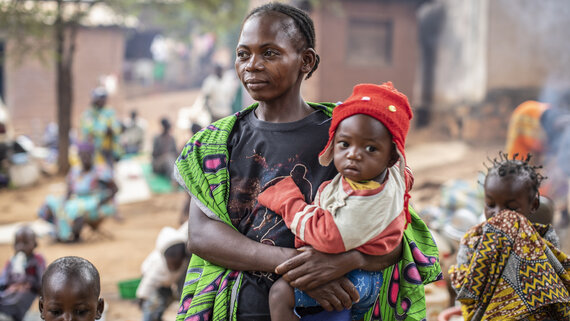Analysis of the context, crisis and needs
An estimated 3.1 million people need humanitarian assistance in the Central African Republic (CAR). Overall, at the intersectoral level, two thirds of the country’s sub-prefectures have reached extreme severity levels (Severity Phase 4, the remaining one third have reached severe severity levels (Severity Phase 3).
According to data from the 2021 Multisectoral Needs Assessment (MSNA), three quarters of adults are concerned about the safety of their household members. The percentage of women and girls who experienced a protection incident in the past 30 days doubled compared to 2020, with gender-based violence (GBV) now being the first protection risk. Blatant violations of human rights, including on minorities, and international humanitarian law are reported. One in four households recently surveyed experienced movement restrictions. Nearly 1 million people have been affected by shocks, as recorded by the alerts issued by the UNICEF/Rapid Response Mechanism (RRM).

Batangafo, CAR
This mother of eight prepares food in front of her house near the sports field at the Batangafo site, CAR. She was part of the first wave of refugees who arrived there in 2014. “We used to sleep like this, with nothing,” says the widow, who sells chikwangue to support her family. “Now there is a bit of calm but still a lot of difficulty finding food for my children.” Batangafo is the city with the second-highest number of IDPs in CAR, with nearly 35,000 people in seven sites.
OCHA/Adrienne SurprenantOne in four Central African has been uprooted from their homes – either within CAR or in neighbouring countries. This is the highest displacement level ever recorded since 2015. Food insecurity is on the rise, with 73 per cent of the population reporting an insufficient food consumption. Nine out of ten Central Africans have resorted to negative coping mechanisms. Seventy per cent of female-headed households now earn less than XAF 30,000 per month (US$54); this proportion increased by 30 per cent compared to last year.
The economy has experienced two difficult years due to the combined impact of COVID-19 and the deteriorating security situation. In 2021, the agricultural harvest decreased by 40 per cent compared to 2020. The number of attacks on civilian infrastructure, such as schools and hospitals, has never been so high. Conflict has severely impacted access for affected civilians to already limited basic services. One in three Central Africans does not have access to essential services within an hour's walk. Security incidents affecting humanitarian workers continued to increase: 364 incidents were recorded from January to October compared to 339 during the same period in 2020. Three humanitarian workers were killed and 24 injured.
Projected situation in 2022 and beyond
The equation is simple and the result dramatic for the Central African population: as the conflict has intensified since December 2020, all the drivers of the humanitarian crisis have worsened (increasing protection risks, increasingly limited access to essential services, deteriorating security situation, upsurge in violent shocks, loss of purchasing power and growing poverty), further worsening the already extremely dire humanitarian situation faced by CAR’s population.

Siwa IDP site, CAR
Two young girls retrieve brown water from a source. There is only one source of water for all displaced people and villagers at the IDP site in Siwa.
OCHA/Adrienne SurprenantWith a score of 7.8, CAR ranks six in the world in terms of risk level according to the INFORM 2021 index, with very high risks of conflict, socioeconomic vulnerabilities and lack of human capital. The projection of the IPC Analysis conducted by the Food Security Cluster indicates that 2.4 million people will be in need if there is no food assistance provided by humanitarian actors during the lean season. According to World Bank projections, more than 3.44 million people, or 70 per cent of the Central African population, are expected to be living in extreme poverty in 2021-2022. By 2025, GDP per capita is expected to be roughly similar to that of 2003.
In the absence of a political solution, there is a significant risk of further deterioration of the overall protection and humanitarian situation in the country. As a result, violence against civilians, civilian infrastructure and humanitarian actors is likely to continue, as will the pressure on humanitarian actors, who anticipate several simultaneous crises in different parts of the country. The most vulnerable population groups, including minorities, will continue to require a sustained and principled humanitarian response.
Response priorities in 2022
The humanitarian community assisted 1.7 million people (94 per cent of the 2021 HRP target) with multisectoral assistance between January and September 2021, despite ever-growing needs and an extremely insecure operating environment. This assistance was thanks to flexible response approaches and mutualization of resources. Three quarters of beneficiaries have reported feeling safe accessing humanitarian assistance, which is higher than last year, and that they trust humanitarian actors.
CAR HRP
In 2022, humanitarian actors aim to target 2 million people. They will underpin their response around two pillars: a) strengthened efforts to protect and assist the most vulnerable, including people living with disabilities, and women, girls and boys who are at risk of GBV; and b) a response as close as possible to those most in need, including in hard-to-reach areas, and informed by affected people’s choices, feedback and participation. Principled, integrated, flexible and multisectoral response approaches in areas under severity 4 will be further scaled up. In line with identified priorities under the humanitarian-development-peace nexus, humanitarian actors will continue to strengthen area-based approaches and complementarity with durable solutions projects, social protection schemes, funding instruments and disaster risk reduction programmes.
Involving the affected population in the decision process

In 2021, the humanitarian response took a qualitative leap by further involving the affected population in decisions that directly affect them and ensuring they remain at the heart of the response. Throughout the HPC, humanitarian actors not only consulted civilians on their needs and preferences as never before, but also contextualized community feedback by population groups, area (urban/rural), local languages, shocks (onset violence, natural disaster). Furthermore, through the CAR Humanitarian Fund, the humanitarian community kick-started the decentralization of collective complaints-and-feedback mechanisms in hotspot areas. This has led to meaningful adjustments on preferred response modalities (i.e. scale of multipurpose cash) and qualitative programming, including on overall accountability (i.e. protection from sexual exploitation and abuse/GBV/protection).
A mother holds her baby boy next to a church in Bangui, which shelters families displaced due to the latest wave of civil unrest.
OCHA/Siegfried ModolaFurther reading
Source: OCHA
Source: Humanitarian Insight
Source: Financial Tracking Service
References
- Based on the Joint Intersectoral Analysis Framework Severity Reference Scale.



